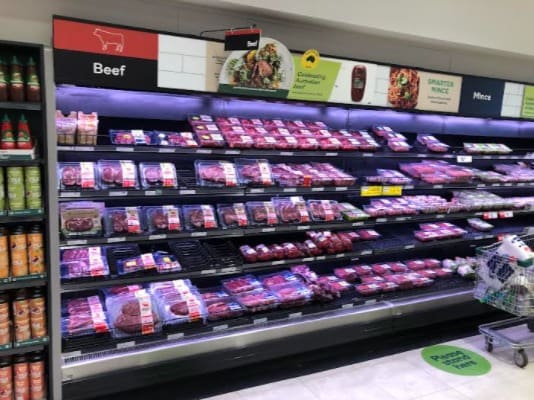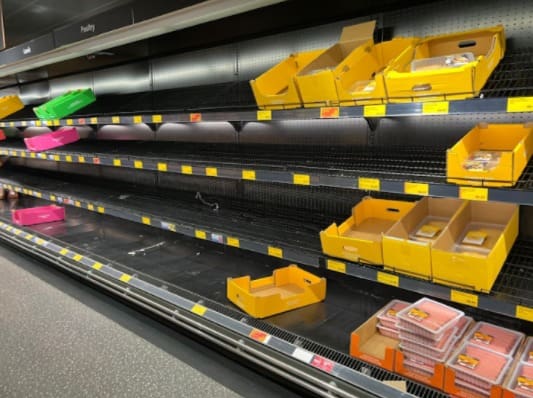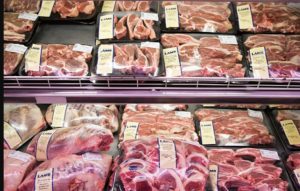
A well-stocked supermarket meat cabinet in Colac Victoria.
COVID constraints on red meat supplies are expected to ease as new close contact rules increasingly take effect among processor and supply chain workforces, and rapid antigen test availability improves.
Some major supermarkets recently applied buying limits for some meat products and NSW Farmers yesterday raised the possibility of bare barbecues on Australia Day as retailer supply chains struggled in the COVID pandemic.
The peak NSW farmer body said the possibility of bare barbecues on Australia Day should be an alarm bell to all sides of politics. Commenting on the domination of food retail by a few major supermarkets and the performance of independent supply chains, NSW Farmers president James Jackson yesterday suggested the Federal Government take another look at competition reform.
“We have seen independent supply chains avoid the worst of the squeeze here in Australia, surely better competition would deliver better results for consumers.
“What we need is a two-pronged approach: more RATs today to get things moving, and real competition reform tomorrow.”

Some retailers have struggled to keep meat cabinets full.
However, Australian Meat Industry Council chief executive officer Patrick Hutchinson said management of ISO requirements has had a successful conclusion for red meat processors, food production and logistics.
Workers in several industries, including meat and food processing, who are close contacts of positive COVID cases are now able to return to work if they are asymptomatic, fully vaccinated and achieve a daily negative RAT test.
“We have worked well with the Federal Government across multiple departments to not only push access to RATs, but the management of ISO requirements, which was first highlighted by AMIC to the government and community over two weeks ago, and has had a successful conclusion for not just meat but all of food production and logistics,” Mr Hutchinson said.
Mr Hutchinson said RAT availability is a problem for all industries in Australia.
“We are told by Fed Government this will be changed next week with a large consignment coming in.
“Further we have seen former COVID positive employees now coming back to work along with those that were isolating that now don’t need to,” he said.
“No NSW-based processors are calling us saying that they are closed currently.”
Mr Hutchinson said the new ISO structures are also now doing what they need to do for Victorian meat processors and along with better staff management and access to RATs “the tide is slowly turning.”
The Victorian Government today said tens of millions more RATs will soon be available to Victorians, with an order for a further 166 million tests building on its initial order of 44 million. The government said more than 4.5 million extra tests landed in Victoria this week, in addition to the 3 million tests that arrived on Sunday.
Mr Hutchinson said based on the essential status of meat processor workers he believed the sector would get better RAT access from the new supplies arriving.
“Our position is simple, RATs should be managed by the employer and provided via them to the employee.
“It stops people racing around looking for RATs to utilise to go to work,” he said.
“It’s best if the work site has them, as to be able to go to work is the reason you want the RAT in the first place.”
Shop around for meat supplies – MLA

Shop around to get that lamb cut for the Australia Day barbecue, says MLA. Image – NSW Farmers
On the prospect of bare supermarket shelves on Australia Day, Meat & Livestock Australia’s domestic market manager Graeme Yardy said it is frustrating with increased on-farm meat production that there are challenges to getting products on retail shelves.
He said MLA had been monitoring retailers and the ability of stores to keep meat shelves stock varied between postcodes.
“Unfortunately the big retailers are really stretched and I know they are doing everything they can to try to get as much product there as possible.”
Mr Yardy suggested consumers shop around at different stores and consider a different cut of lamb from available supplies for the Australia Day barbecue.
“Keep an eye out and check back; if it is not there today, check tomorrow.
“Retailers are getting deliveries all the time, but I know they are really stretched getting it on the shelves.”
A Coles spokesperson said every sector of the economy is experiencing labour shortages as a result of the increased number of workers isolating.
“We are working collaboratively with our suppliers and we are optimistic about our supply pipeline of all products, including lamb in coming weeks.
“We thank our customers for their patience as we work with our suppliers and transport partners to increase deliveries and return a full range of products to our stores,” the spokesperson said.
“We ask that they continue to treat our team with kindness and respect, and to purchase only what they need.”
A Woolworths spokesperson said the group was working with its lamb suppliers to deliver as much stock as possible to stores amid the ongoing disruptions to meat processing and grocery supply chains across the country.
“We understand that processors have been particularly impacted by high levels of COVID-related absenteeism in recent weeks, and together we’re working to maximise their capacity by prioritising key lines for our customers.
“While we continue to send meat to our stores daily, we know there are gaps on our shelves at the moment and we thank our customers for their understanding as we continue to work through these challenges with our suppliers over the coming weeks.”
MLA report recovering slaughter levels
Meat & Livestock Australia said although lamb and cattle slaughter numbers are below 2020 and 2021 levels so far this year, circumstances are improving.
Changes to the national definition of a close contact and isolation rules for abattoir workers have seen the weekly kill numbers improve this week, MLA said. National cattle slaughter improved 50 percent this week to 62,000 head while lamb slaughter rose by 100,000 head this week to 319,000 head. These numbers are encouraging, although cattle slaughter is down 28pc and lamb slaughter is down 29pc from the same week last year, MLA said.
In WA, where the current Omicron outbreak has not yet exploded, MLA said processing 46,264 head of lambs – above 2020 levels of 45,500 and only slightly below 2021 levels. NSW, which some reports indicate has passed the peak of the Omicron outbreak, is observing a similar trend. Weekly lamb slaughter in NSW is 100,886, above the 98,000 head recorded in 2020 when the state was still in drought and experiencing lower marking and joining rates, MLA said.
In Tasmania, the 7434 head of lambs processed this week is above the weekly slaughter of both 2020 and 2021 – great news for lamb producers in the island state who are looking to turn lambs off, MLA said. National weekly goat slaughter was 30,000 head last week, up 25pc on 2021 levels.

HAVE YOUR SAY